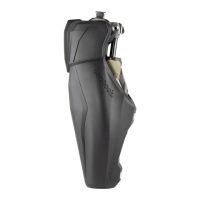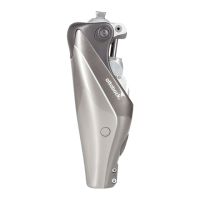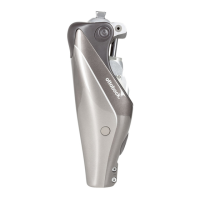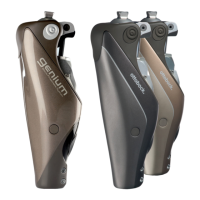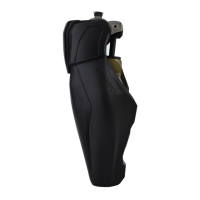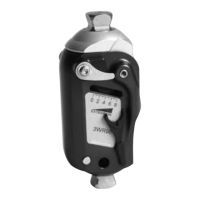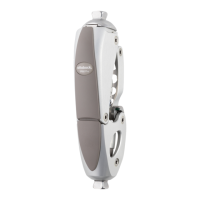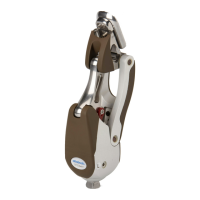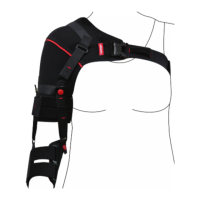Do you have a question about the Otto Bock Genium X3 3B5-2 and is the answer not in the manual?
Ensure remote control compatibility by checking version 1.0.0.6 or higher for full functionality.
Details the components of the prosthesis, including the proximal pyramid adapter, battery, and hydraulic unit.
Explains the microprocessor-controlled stance and swing phase functionality and adaptive features.
Lists compatible Ottobock components, including adapters, tube adapters, prosthetic feet, and implant system connections.
Specifies that the product is solely for lower limb exoprosthetic fittings.
Defines the application area according to Ottobock's MOBIS classification.
Details intended everyday use, not unusual activities, and limits body weight to 125 kg.
Lists patient types for use, including amputees and dysmelia patients, requiring specific capabilities.
States that fitting must be done by Ottobock-authorised qualified personnel with specific training.
Defines the meaning of WARNING, CAUTION, and NOTICE symbols for potential hazards and damage.
Explains how safety instructions are presented, including hazard source, consequences, and required actions.
Covers warnings for non-observance, use of damaged parts, and handling the power supply unit.
Addresses safety regarding power supply use, charging, and potential damage from incorrect voltage or polarity.
Details safety precautions for battery charger operation, including avoiding dirt, mechanical stress, and incorrect usage.
Safety notes on using suitable components, proper screw assembly, and alignment procedures to prevent falls or breakage.
Warns about HF devices, magnetic fields, and temperature ranges affecting product performance and safety.
Covers safety during walking, climbing stairs, overcoming obstacles, and handling mode switching or stance function.
Discusses safety mode, implant system loads, and cockpit app usage safety to prevent unexpected behaviour.
Lists all components included in the product package, such as the prosthesis, adapters, power supply, and documentation.
Lists optional components that can be ordered separately, like protective covers and remote controls.
Step-by-step guide on connecting the power supply and battery charger to the wall outlet and the prosthesis.
Details the process of connecting the inductive charger and indicators for charging status.
Explains how to check the battery level using beep signals, the Cockpit app, or the remote control.
Guidance on connecting the knee joint to a prosthetic socket and ensuring biomechanically correct alignment.
Details on using the X-Soft software for patient-specific product settings and software updates.
Instructions for correctly shortening the tube adapter, ensuring cable integrity and proper fit.
Steps for installing the tube adapter, connecting cables, and ensuring correct insertion depth and torque.
Guidelines for bench alignment using apparatus or laserline, emphasizing correct shoe usage and full extension.
Using adjustment software for concrete reference values to optimise alignment for minimal patient compensation.
Performing dynamic optimisation during trial walking, adapting aspects like socket position and foot rotation.
Specifies the correct torque values for various screw connections to ensure secure assembly.
Verifying distances between the socket and knee joint at maximum flexion/extension to prevent collision and damage.
Details on the knee joint's flexion stop, its purpose, types, and procedures for removal and insertion.
Lists compatible Android devices and operating system versions for the Cockpit app.
Key points to observe before establishing the first connection, including Bluetooth activation and device requirements.
Steps for launching the app, accepting the EULA, and adding a new component.
Overview of the app's interface, including navigation menu, product status, and mode selection.
Details the options available in the navigation menu, such as Product, MyModes, Functions, and Settings.
Information on storing and managing connections with up to four components, and adding new components.
Step-by-step instructions for adding a new prosthesis or device to the Cockpit app.
Procedure for removing a component from the app's stored connections.
Guidance on managing component connections across different devices and handling connection conflicts.
Describes basic mode functionality, including standing, walking, and sitting, and the stance function.
Details the knee joint's control during standing, including intuitive and deliberate locking mechanisms.
Explains how to enable and use the stance function for improved stability on inclines.
Instructions for walking with the prosthesis, emphasizing stance and swing phase control by hydraulics.
Details the automatic transition to running, changes in swing phase angle, and preFlex reduction.
Guidance on how to sit down, ensuring controlled flexion and weight distribution.
Describes the energy saving mode during sitting and the optional sitting function for free leg swing.
Steps for standing up, involving foot placement, body lean, and weight distribution.
Instructions for negotiating stairs step-by-step, requiring practice and conscious execution.
How to use the stair function to cross obstacles, involving hip extension and flexion.
Procedure for walking down stairs, ensuring correct foot placement and controlled flexion.
Using increased flexion resistance to permit controlled knee flexion when walking down a ramp.
How to adjust prosthesis settings using the Cockpit app or remote control, including checking selected prosthesis.
Step-by-step guide to changing parameters like resistance, angle, and function activation within the Cockpit app.
Details parameters adjustable in basic mode, including resistance, angle, and activating/deactivating functions.
Lists modifiable parameters for MyModes, such as gain, pitch, volume, and stance function for specific motion patterns.
Describes the 'Running' MyMode for extended periods, including its configuration and compatible prosthetic feet.
How to select different MyModes using the Cockpit app after establishing a connection.
Procedure for switching between MyModes by performing specific motion patterns, with requirements and sequence.
Methods to switch back to basic mode from a MyMode, using motion patterns or the battery charger.
Describes the state when the battery is critically low, leading to safety mode damping and eventual shutdown.
Indicates the prosthesis is non-functional during charging and defaults to safety mode damping.
Explains activation of safety mode due to critical faults, its limited functionality, and deactivation procedures.
Describes overheating mode activation due to high activity, its indication, and deactivated functions.
Guidance on proper storage to prevent hydraulic issues and information on the automatic bleeding mechanism.
Steps for cleaning the product using fresh water, drying, and air drying.
Methods for identifying the product's settings (factory or user) by an authorised service center.
Defines the manufacturer's liability based on product use according to instructions and disclaims liability for misuse.
Information that product names are subject to trademark laws and belong to their respective owners.
States compliance with European directives for medical devices, radio equipment, and RoHS.
Covers FCC and Industry Canada compliance, including rules on interference and RF exposure.
Details operating, storage, and transportation conditions including temperature and humidity limits.
Provides key product details like article number, weight, maximum body weight, and protection rating.
Lists specifications for the prosthesis battery, power supply, and battery charger, including charging times.
Provides the article number for the Cockpit app.
Explains the meaning of various symbols used throughout the manual, such as legal manufacturer, IP ratings, and CE marking.
Lists signals for battery charger connection, disconnection, and mode switching events.
Describes error signals like overheating, low battery, and safety mode activation, with required actions.
Lists error messages during app connection, causes, and corrections, e.g., device not found or connection interrupted.
Provides status signals related to the battery charger, including connection status and errors.
Details signals for maintenance notes and self-test errors, including required actions and product usage.
| Brand | Otto Bock |
|---|---|
| Model | Genium X3 3B5-2 |
| Category | Medical Equipment |
| Language | English |

